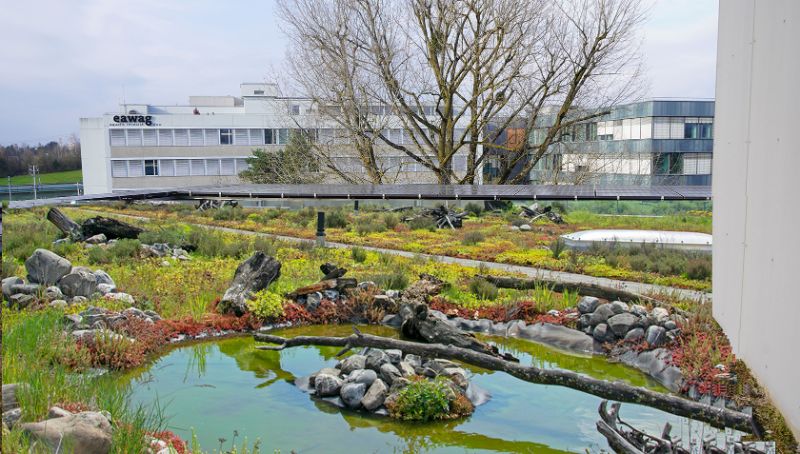Sponge city also stores energy
Blue-green infrastructure should make our cities more liveable. Water basins and lots of greenery can prevent heat islands and create living space at the same time. In addition, the basins and the vegetation, which is deliberately built up like an absorbent sponge, act as a buffer. This means that not all the water runs off at the same time during increasingly intense rainfall. This breaks up the flood peaks, reduces the flooding of underpasses or cellars and the retained water can be used to irrigate the green areas in the next dry period.
Win-win-win situation
Several research projects that Eawag has been carrying out for years together with Empa and WSL have now shown that this win-win situation can be extended even further. Namely, when the water basins on the roofs of buildings are used as pumped storage. The principle is simple: surplus solar or wind power is used to pump water up into the basins during the day. During the night, in bad weather or generally when the demand for electricity exceeds the sustainably produced supply, the water from the basins in the basement of the building is converted into electricity using standard small turbines.
The pilot plant in Eawag's main Forum Chriesbach building in Dübendorf supplies around 8,000 kilowatt hours of electricity per year. "That may not seem much compared to the Grande Dixence," says Eawag-Empa Environmental Officer Dionys Hallenbarter, "but it's a huge success for us." According to the energy expert, this electricity is extremely valuable because it can be produced exactly when it is needed. In addition, the pilot system in Dübendorf, which was funded by the Swiss Federal Office of Energy, was primarily created for research purposes. The "proof of concept", i.e. the proof that it works, has now been provided and work can be done on optimizations, for example how solar panels arranged above the water basins can produce the electricity needed for pumping up the water.
Just one percent of the buildings would create an entire reservoir
A joint study by the Departments of Environmental Social Sciences and Systems Modeling has investigated how the principle could be extended to the entire Swiss building stock. The group is publishing the results today in the renowned journal Environmental Science and Technology: if just one percent of suitable buildings were equipped with similar systems, the controllable energy content would be to that of the Zervreila reservoir in the Vals Valley in the canton of Grisons.
Research with impact
Zurich's Minister of Construction Martin Neukom, a regular visitor to the innovative Eawag and Empa campus in Dübendorf, is enthusiastic: "Now we have to work in Bern to ensure that such multifunctional and controllable roof systems become mandatory for new buildings and major building renovations," he says. Eawag Director Martin Ackermann is also convinced: "Just talking about climate change is not enough. Thanks to the joint projects, we can now show that research has a lasting effect."
